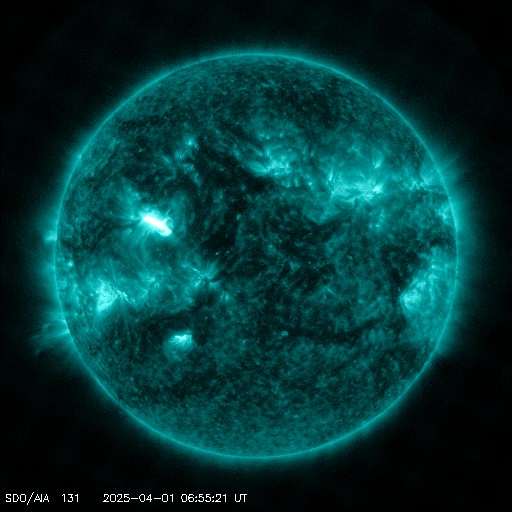Viewing archive of Tuesday, 3 July 2012
Solar activity report
Any mentioned solar flare in this report has a scaling factor applied by the Space Weather Prediction Center (SWPC). Because of the SWPC scaling factor, solar flares are reported as 42% smaller than for the science quality data. The scaling factor has been removed from our archived solar flare data to reflect the true physical units.
Report of Solar-Geophysical Activity 2012 Jul 03 2200 UTCPrepared by the NOAA © SWPC and processed by SpaceWeatherLive.com
Joint USAF/NOAA Report of Solar and Geophysical Activity
SDF Number 185 Issued at 2200Z on 03 Jul 2012IA. Analysis of Solar Active Regions and Activity from 02-2100Z to 03-2100Z
Solar activity was moderate. Region 1515 (S16W10)
remained the predominant flare producer with an M2/Sf flare at
02/2356Z and frequent C-class flares including a C9/Sf at 03/0342Z
associated with a 260 sfu Tenflare. This region, classified as an
Fkc/beta-gamma-delta, remained large and magnetically complex with
delta magnetic configurations within its interior and trailer spots.
Several coronal mass ejections (CME) were associated with flare
activity in Region 1515, but the bulk of the ejecta was directed
southward, out of the ecliptic plane. Region 1513 (N16W22) retained
its beta-gamma magnetic configuration and displayed no significant
changes during the period. It produced isolated C-class flares
including a C8/Sf at 03/1441Z associated with a Type II radio sweep
(estimated shock velocity 1064 km/s). No new regions were numbered.
IB. Solar Activity Forecast
Solar activity is expected to be
moderate through the period (04 - 06 July) with more M-class flares
expected from Region 1515.
IIA. Geophysical Activity Summary 02-2100Z to 03-2100Z
Geomagnetic field activity was at quiet to unsettled levels with
active to minor storm periods detected at high latitudes. ACE solar
wind data indicated Earth remained within a negative-polarity
coronal hole high-speed stream (CH HSS). Wind speeds were in the 504
to 715 km/s range with a gradual decreasing trend. The Bz component
of the interplanetary magnetic field was variable in the +4/-4 nT
range. The greater than 2 MeV electron flux at geosynchronous orbit
reached high levels during the period.
IIB. Geophysical Activity Forecast
Geomagnetic field activity is
expected to be at quiet to unsettled levels through the period (04 -
06 July) with a chance for active levels due to persistent CH HSS
effects. Recent CME activity from Region 1515 is not expected to
significantly disturb the geomagnetic field.
III. Event Probabilities 04 Jul to 06 Jul
| Class M | 70% | 70% | 70% |
| Class X | 10% | 10% | 10% |
| Proton | 05% | 05% | 05% |
| PCAF | green | ||
IV. Penticton 10.7 cm Flux
Observed 03 Jul 146 Predicted 04 Jul-06 Jul 150/155/155 90 Day Mean 03 Jul 120
V. Geomagnetic A Indices
Observed Afr/Ap 02 Jul 018/022 Estimated Afr/Ap 03 Jul 008/010 Predicted Afr/Ap 04 Jul-06 Jul 007/008-007/008-009/008
VI. Geomagnetic Activity Probabilities 04 Jul to 06 Jul
| A. Middle Latitudes | |||
|---|---|---|---|
| Active | 20% | 20% | 20% |
| Minor storm | 05% | 05% | 05% |
| Major-severe storm | 01% | 01% | 01% |
| B. High Latitudes | |||
|---|---|---|---|
| Active | 20% | 20% | 15% |
| Minor storm | 30% | 30% | 15% |
| Major-severe storm | 30% | 30% | 05% |
All times in UTC
Current data suggests there is a slight possibility for aurora to appear at the following high latitude regions in the near future
Gillam, MB, Iqaluit, NUNuuk
Reykjavik
Latest news
Latest forum messages
AR4048 82Unspecified geomagnetic activity 2179AR4046 152We are launching a dating app! SpaceWeatherLove! Download it today! 6Deep Flare Net 2
More topicsSupport SpaceWeatherLive.com!
A lot of people come to SpaceWeatherLive to follow the Sun's activity or if there is aurora to be seen, but with more traffic comes higher server costs. Consider a donation if you enjoy SpaceWeatherLive so we can keep the website online!

Latest alerts
01:45 UTC - Geomagnetic activity
Active geomagnetic conditions (Kp4) Threshold Reached: 01:32 UTC
Tuesday, 1 April 2025
22:51 UTC - Solar flare
Moderate M2.5 flare
22:30 UTC - Radio Blackout
Minor R1 radio blackout in progress (≥M1 - current: M1.45)
07:15 UTC - 10cm Radio Burst
Begin Time: 01/04/2025 06:45 UTC Maximum Time: 01/04/2025 06:45 UTC Duration: 1 minutes. Peak flux: 190 sfu
07:06 UTC - Solar flare
Strong M5.61 flare
Space weather facts
| Last X-flare | 2025/03/28 | X1.1 |
| Last M-flare | 2025/04/01 | M2.4 |
| Last geomagnetic storm | 2025/03/27 | Kp5 (G1) |
| Spotless days | |
|---|---|
| Last spotless day | 2022/06/08 |
| Monthly mean Sunspot Number | |
|---|---|
| February 2025 | 154.6 +17.6 |
| Last 30 days | 128.1 -22.5 |





